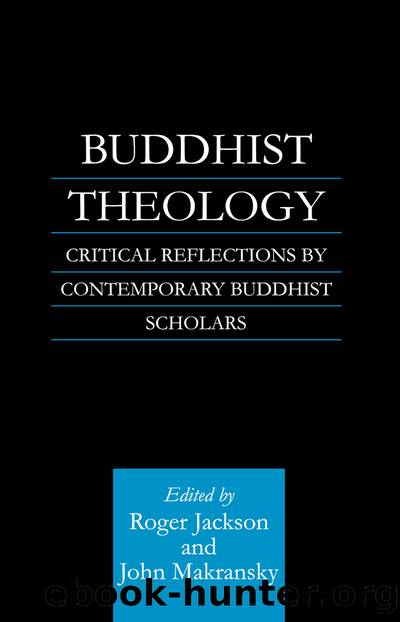BUDDHIST THEOLOGY by Unknown

Author:Unknown
Language: eng
Format: epub
ISBN: 978-1-136-83012-9
Publisher: Routledge
Ten
The Dialectic Between Religious Belief and Contemplative Knowledge in Tibetan Buddhism
B. Alan Wallace
I would like to present this essay as an example of a Buddhist theoretical critique of the relation between religious belief and contemplative knowledge in Tibetan Buddhism, and I shall contrast this with Steven Katz’s and Paul Griffiths’s academic analyses of mysticism and Buddhist insight practice. A tension has long existed in the Tibetan Buddhist tradition between religious belief based upon scriptural authority and contemplative knowledge drawn from firsthand, personal inquiry. While many of the great scholars and contemplatives of Tibet have emphasized the importance of a balance between these two themes, when a contemplative tradition degenerates, this tension is lost: scholars devote themselves exclusively to textual study, disclaiming the present possibility of experiential knowledge; while contemplatives disdain textual knowledge as dry intellectualism, thereby reducing their tradition to a system of theoretically barren techniques.
The very possibility of genuine contemplative inquiry and insight has been called into question by modern scholars of mysticism and Buddhism. Steven Katz, for example, claims that religious images, beliefs, symbols, and rituals define, in advance, the types of experiences a contemplative wants to have and does eventually have (1978: 33). In a similar vein, Paul Griffiths states that the Buddhist cultivation of contemplative insight (Pāli vipassanā-bhāvanā) consists of “repeated meditations upon standard items of Buddhist doctrine … until these are completely internalized by practitioners and their cognitive and perceptual habit-patterns operate only in terms of them” (13). Thus, according to the above interpretations, mystical experience in general and the Buddhist cultivation of insight in particular entail no genuine, open-minded inquiry, but rather a self-imposed form of indoctrination (Griffiths: 15). I shall argue, however, that this description characterizes Buddhist meditation only in its more degenerate forms and is therefore a misleading depiction of the tradition as a whole.
Within Tibetan Buddhism, the sect that most readily lends itself to the critique of Katz and Griffiths is probably the dGe lugs order, which over the past few centuries has become highly scholastic in theory and practice. Its appeal to scriptural authority and rational argument can be traced to the writings of Tsong kha pa (1357–1419), the founder of this order. For example, in his classic work entitled The Great Exposition of the Path to Awakening1 his erudite discussions of the cultivation of meditative quiescence (śamatha) and insight (vipaśyanā) are based almost entirely upon the Buddhist canon, including sūtras attributed to the Buddha and Sanskrit commentaries composed by the patriarchs of Indian Mahāyāna Buddhism. The accounts of these two fundamental approaches to Buddhist meditation are standardized and essentially normative, with virtually no descriptions of contemplatives’ own firsthand accounts of their individual experience. Moreover, these presentations include almost no references to the written accounts of Tibetan contemplatives, even though, by Tsong kha pa’s time, the techniques for developing meditative quiescence and insight had been practiced in Tibet for more than five hundred years.
Advocates of the dGe lugs order defend this reliance upon textual authority and rational analysis in terms of the traditional, threefold sequence of Buddhist praxis, namely hearing, thinking, and meditation.
Download
This site does not store any files on its server. We only index and link to content provided by other sites. Please contact the content providers to delete copyright contents if any and email us, we'll remove relevant links or contents immediately.
Adulting by Kelly Williams Brown(3671)
Figure Drawing for Artists by Steve Huston(2799)
Draw Your Day by Samantha Dion Baker(2708)
Drawing Cutting Edge Anatomy by Christopher Hart(2678)
Drawing Shortcuts: Developing Quick Drawing Skills Using Today's Technology by Leggitt Jim(2532)
Make Comics Like the Pros by Greg Pak(2423)
Draw to Win: A Crash Course on How to Lead, Sell, and Innovate With Your Visual Mind by Dan Roam(2277)
How Proust Can Change Your Life by Alain De Botton(2261)
Day by Elie Wiesel(2243)
0041152001443424520 .pdf by Unknown(2220)
How The Mind Works by Steven Pinker(2214)
Rapid Viz: A New Method for the Rapid Visualization of Ideas by Kurt Hanks & Larry Belliston(2195)
Modern Cartooning by Christopher Hart(2189)
Poses for Artists Volume 2 - Standing Poses: An essential reference for figure drawing and the human form. (Inspiring Art and Artists) by Justin Martin(2145)
Draw-A-Saurus by James Silvani(2105)
Learn Drawing Quickly by Sharon Finmark(2090)
Tattoo Art by Doralba Picerno(2083)
Poses for Artists - Dynamic & Sitting: An essential reference for figure drawing and the human form (Inspiring Art and Artists Book 1) by Justin R Martin(2063)
Drawing and Painting Birds by Tim Wootton(2001)
